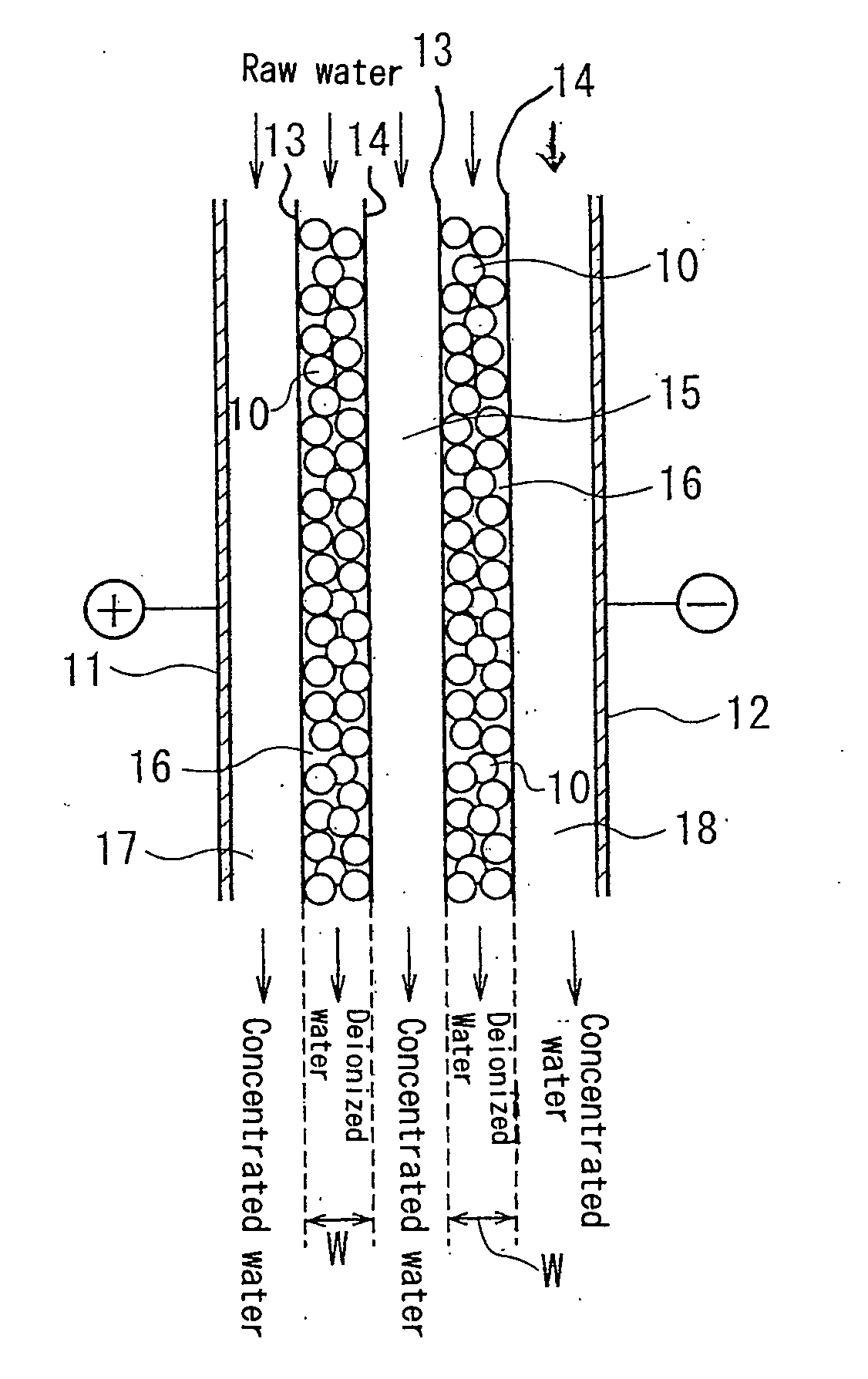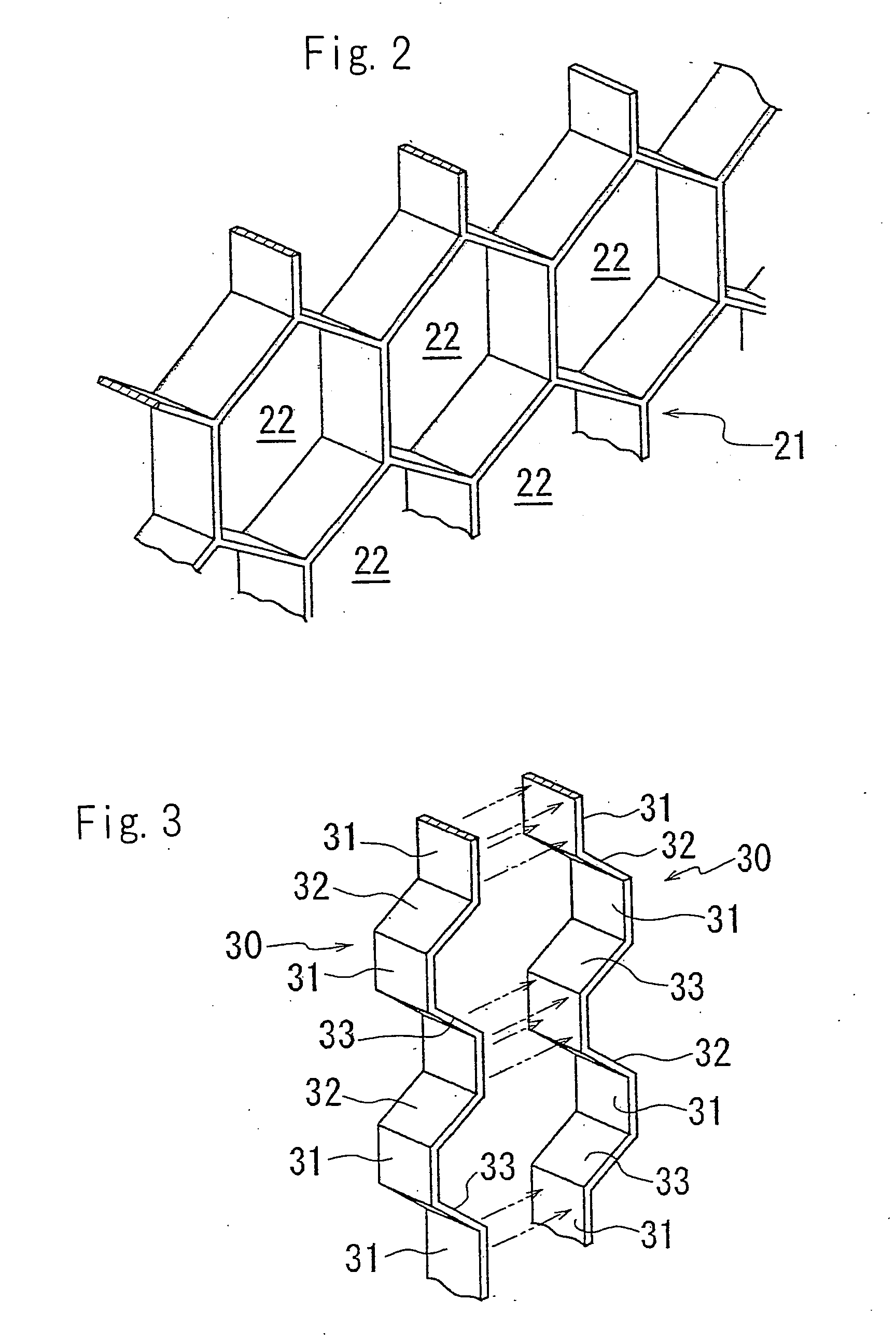Apparatus and method for electrodeionization
a technology of electrodeionization and electrodes, which is applied in the direction of fluid pressure measurement, liquid/fluent solid measurement, peptide measurement, etc., can solve the problems of poor contact efficiency between water and ion exchange resin, weak electrolytes such as carbonic acid, silica and the like are difficult to be removed from water to be treated, and the rate of filling ion exchange resin is poor. , to achieve the effect of reducing the amount of ion exchanger
Active Publication Date: 2006-11-30
KURITA WATER INDUSTRIES LTD
View PDF1 Cites 13 Cited by
- Summary
- Abstract
- Description
- Claims
- Application Information
AI Technical Summary
Benefits of technology
[0056] When the ratio of anion exchange resin in the highly excessive zone is lower than 66 volume %, the amount of OH− ions produced by water dissociation is insufficient and carbonic acid is ionized to bicarbonate ion at an insufficient rate, thereby removal rate of the carbonic acid is decreased. When the ratio of anion exchange resin in the highly excessive zone is higher than 80 volume %, removal rate of cations including Na+ ions decreases, thereby the concentration of Na+ ion and the like in the treated water is increased. When the ratio of anion exchange resin is in the range of 66 to 80 volume % in the highly excessive zone, carbonic acid, Na+ ion and the like are sufficiently removed, and further ionization of silica, which is a weak acid, is promoted so that removal rate of silica is increased. When the ratio of anion exchange resin in the slightly excessive zone is lower than 50 volume %, anions tend to leak from this zone. When the ratio of anion exchange resin is higher than 65 volume % in the slightly excessive zone, cations tend to leak from this zone, thereby the effect of the invention can not be obtained.
[0057] The desalting compartment may-have, between the highly excessive zone and the slightly excessive zone, a moderately excessive zone where a ratio of the anion exchange resin is between those in the highly excessive zone and the slightly excessive zone. The ratio of the anion exchange resin may vary within the above range in both the highly excessive zone and the slightly excessive zone. The ratio may be increased or decreased continuously from the upstream side to the downstream side in each zone within the above range.
[0058] The apparatus according to the invention can be operated at a current density of 300 mA / dm2 or more, for example, 300 to 120 mA / dm2, so that treated water having a high resistivity of 10M Ω·cm or higher can be produced even when raw water to be treated has a Na ion concentration of 300 ppb or more, for example, 300 to 2000 ppb.
[0059] Though the cells are hexagonal in FIGS. 1 through 4, the cells may be quadrangular e.g. rhombic. The partition member may be a triangle-type partition member composed of triangular cell. The partition member may form cells having other shapes. The apparatus may have no cells, wherein the apparatus has no partition member.
[0060] In the electrodeionization apparatus of the present invention, the projected area to the ion exchange membrane of the cells is preferably 1 to 100 cm2, particularly 5 to 80 cm2, more particularly 10 to 50 cm2. The distance between a pair of the anion exchange membrane and the cation exchange membrane via the desalting compartment i.e. the thickness of the desalting compartment is preferably 1.5 to 15 mm, particularly 3 to 10 mm. As the size of the cells is reduced, the amount of the ion exchanger to be filled in one cell is reduced so that the fluidization of the ion exchanger is restrained. In addition, the strength of the partition member and the strength of the desalting compartment are increased. However, the pressure loss of the water flowing in the desalting compartment is increased.
[0061] The concentrating compartment in one aspect may have a thickness of 0.3 to 1 mm and may be provided with a spacer of 20 to 60 meshes therein.
Problems solved by technology
Further, the flow of the water in a lateral direction is blocked by the ribs, so that the contact efficiency between the water and the ion exchange resins is poor.
In addition, the ion exchange resins are compressed at lower portions of the cells so that the cells have a vacancy at upper portions thereof, whereby the rate of filling the ion exchange resins tends to be poor.
Therefore, weak electrolytes including carbonic acid, silica and the like are hard to be removed from the water to be treated.
As the amount ratio of the anion exchange resin increases, the amount of OH− ions to be produced also increases, but the removing rate of Na+ ions is deteriorated because the amount of H+ ions decreases, thereby the treated water is deteriorated in resistivity.
Method used
the structure of the environmentally friendly knitted fabric provided by the present invention; figure 2 Flow chart of the yarn wrapping machine for environmentally friendly knitted fabrics and storage devices; image 3 Is the parameter map of the yarn covering machine
View moreImage
Smart Image Click on the blue labels to locate them in the text.
Smart ImageViewing Examples
Examples
Experimental program
Comparison scheme
Effect test
example 2
[0074] Upper stream zone:60% lower stream zone:75%
the structure of the environmentally friendly knitted fabric provided by the present invention; figure 2 Flow chart of the yarn wrapping machine for environmentally friendly knitted fabrics and storage devices; image 3 Is the parameter map of the yarn covering machine
Login to View More PUM
| Property | Measurement | Unit |
|---|---|---|
| current density | aaaaa | aaaaa |
| volume % | aaaaa | aaaaa |
| angle | aaaaa | aaaaa |
Login to View More
Abstract
An electric deionization device capable of sufficiently removing weak electrolyte components and producing processed desalting chamber having rectangular-parallelepiped frame 20, a compartment member 21 disposed in the frame 20 and, desirably, having conductivity, an ion exchange resin 23 filled in small chambes 22 formed by the compartment member 21, and an anion exchange membrane 24 and a cation exchange membrane 25 disposed so as to hold the frame 20. The compartment member 21 is formed in a hexagonal honeycomb shape. The ion exchange membrane 23 is the mixture of an anion exchange resin with a cation exchange resin, and its mixing ratio on the upstream side is different from that on the downstream side.
Description
CROSS REFERENCE TO RELATED APPLICATION [0001] This is a continuation application of PCT / JP2004 / 019300 filed on Dec. 24, 2004.FIELD OF THE INVENTION [0002] The present invention relates to an electrodeionization apparatus used for producing deionized water in various fields including semiconductor manufacturing, liquid crystal display manufacturing, pharmaceutical manufacturing, food processing, and the like. More particularly the present invention relates to the electrodeionization apparatus which produces treated water which is improved in resistivity and removing rate of weak electrolyte anions and is suitable to produce highly pure water continuously. Further more, the present invention relates to a method for electrodeionization which employs the electrodeionization apparatus. BACKGROUND OF THE INVENTION [0003] The electrodeionization apparatus used for producing the deionized water is employed in various fields including the semiconductor manufacturing plants, the liquid crysta...
Claims
the structure of the environmentally friendly knitted fabric provided by the present invention; figure 2 Flow chart of the yarn wrapping machine for environmentally friendly knitted fabrics and storage devices; image 3 Is the parameter map of the yarn covering machine
Login to View More Application Information
Patent Timeline
 Login to View More
Login to View More Patent Type & Authority Applications(United States)
IPC IPC(8): B01D61/42B01D61/48B01J47/08C02F1/469
CPCB01D61/48C02F1/4695B01J47/08Y02A20/124C02F1/469
Inventor IWASAKI, KUNIHIRO
Owner KURITA WATER INDUSTRIES LTD
Features
- R&D
- Intellectual Property
- Life Sciences
- Materials
- Tech Scout
Why Patsnap Eureka
- Unparalleled Data Quality
- Higher Quality Content
- 60% Fewer Hallucinations
Social media
Patsnap Eureka Blog
Learn More Browse by: Latest US Patents, China's latest patents, Technical Efficacy Thesaurus, Application Domain, Technology Topic, Popular Technical Reports.
© 2025 PatSnap. All rights reserved.Legal|Privacy policy|Modern Slavery Act Transparency Statement|Sitemap|About US| Contact US: help@patsnap.com



